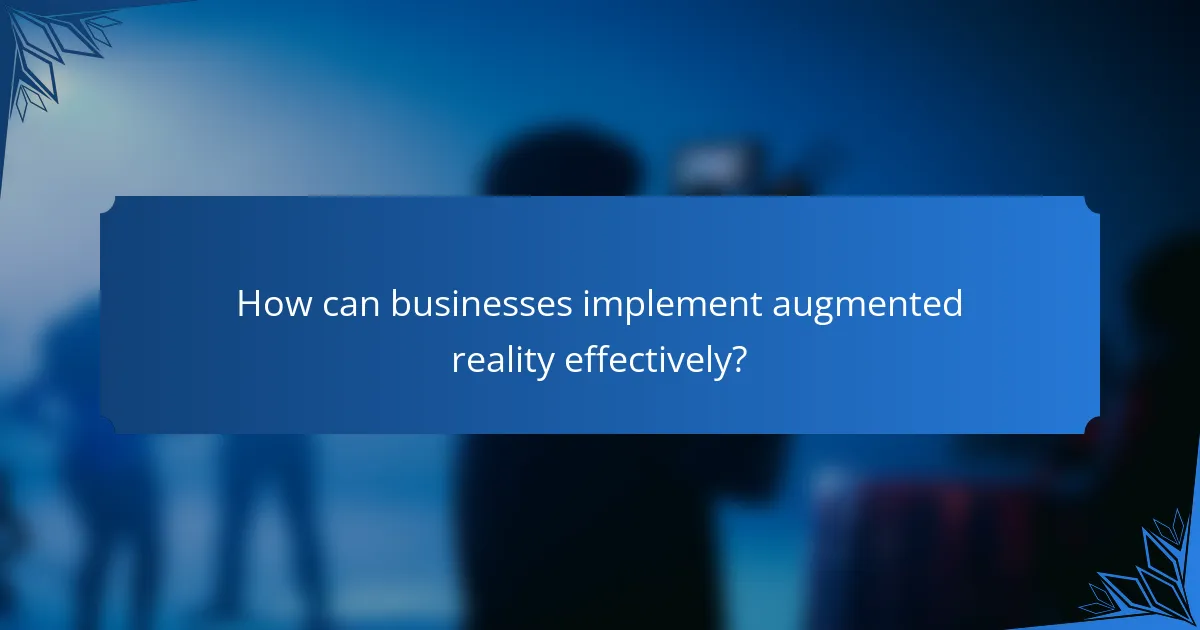Augmented reality (AR) revolutionizes user engagement by merging digital content with the real world, creating interactive experiences that capture attention and foster emotional connections. In marketing, AR tools enhance customer interactions, enabling informed purchasing decisions and enriching the overall shopping experience. By strategically integrating AR into their operations, businesses can effectively connect with their target audience and achieve their marketing objectives.

How does augmented reality enhance user engagement?
Augmented reality (AR) enhances user engagement by creating interactive and immersive experiences that captivate users’ attention. By overlaying digital content onto the real world, AR allows brands to connect with consumers in innovative ways, fostering deeper emotional connections and increasing participation.
Interactive advertising campaigns
Interactive advertising campaigns leverage AR to create engaging experiences that encourage user participation. For example, users can scan a product’s packaging with their smartphones to unlock exclusive content, such as videos or discounts. This approach not only captures attention but also drives conversions by providing an interactive element that traditional ads lack.
Brands should consider using AR to enhance their promotional efforts, ensuring that the experience is seamless and easy to access. Clear instructions and intuitive design are essential to avoid frustrating users and to maximize engagement.
Immersive brand experiences
Immersive brand experiences utilize AR to transport users into a brand’s universe, making them feel part of the story. For instance, furniture retailers often offer AR apps that allow customers to visualize how a piece of furniture would look in their own homes. This not only aids decision-making but also creates a memorable interaction with the brand.
To implement this effectively, brands should focus on high-quality visuals and user-friendly interfaces. Ensuring compatibility across various devices can also enhance accessibility and broaden the audience reach.
Gamification in marketing
Gamification in marketing uses AR to incorporate game-like elements into promotional strategies, making the experience more enjoyable and engaging. For example, brands can create scavenger hunts where users find virtual items in real-world locations, earning rewards or discounts as they participate.
When designing gamified experiences, it’s crucial to balance fun with clear objectives. Brands should avoid overly complex rules and ensure that rewards are appealing enough to motivate participation. Simple, engaging tasks can significantly boost user interaction and brand loyalty.

What are the key applications of augmented reality in marketing?
Augmented reality (AR) in marketing enhances customer engagement by blending digital content with the real world. Key applications include product visualization tools and dedicated AR apps for retail, which help consumers make informed purchasing decisions and improve their overall shopping experience.
Product visualization tools
Product visualization tools allow consumers to see how a product will look in their environment before making a purchase. For example, furniture retailers often use AR to let customers visualize how a sofa fits in their living room. This interactive experience can significantly reduce return rates and increase customer satisfaction.
When implementing product visualization, consider the quality of the AR experience. High-resolution graphics and accurate scaling are crucial for creating a realistic representation. Additionally, ensure that the tool is user-friendly and accessible across various devices, including smartphones and tablets.
Augmented reality apps for retail
Augmented reality apps for retail enhance the shopping experience by providing interactive features such as virtual try-ons and in-store navigation. For instance, beauty brands often offer apps that allow users to see how makeup products look on their skin before buying. This not only boosts engagement but also encourages purchases.
To effectively use AR apps in retail, focus on seamless integration with existing platforms and ensure that the app is easy to navigate. It’s essential to keep the content fresh and relevant to maintain user interest. Additionally, consider the potential for personalized experiences based on user preferences and behaviors, which can further enhance engagement.

How can businesses implement augmented reality effectively?
Businesses can implement augmented reality (AR) effectively by selecting the right technology and integrating it seamlessly into their existing operations. This involves understanding the target audience, choosing appropriate platforms, and aligning AR experiences with marketing goals.
Choosing the right AR platform
Selecting the right AR platform is crucial for successful implementation. Businesses should consider factors such as user experience, compatibility with devices, and the specific features offered by different platforms. Popular options include ARKit for iOS, ARCore for Android, and web-based solutions that require no app download.
Evaluate platforms based on ease of use, development costs, and the ability to scale. For instance, if targeting a younger audience, a mobile-centric platform may be more effective, while industries like retail might benefit from web-based AR for broader accessibility.
Integrating AR with existing marketing strategies
To integrate AR with current marketing strategies, businesses should ensure that AR experiences enhance their brand messaging and customer engagement. This can be achieved by creating interactive campaigns that allow users to visualize products in their environment, such as furniture or clothing.
Consider using AR in social media campaigns, where users can share their experiences, or in email marketing to provide immersive content. A successful approach might involve a blend of AR and traditional marketing tactics, ensuring that the AR component feels like a natural extension of the overall strategy.

What are the benefits of augmented reality for customer experiences?
Augmented reality (AR) significantly enhances customer experiences by providing interactive and immersive ways to engage with products. This technology allows customers to visualize items in their own environment, leading to more informed purchasing decisions and increased satisfaction.
Increased customer retention
Augmented reality can lead to higher customer retention by creating memorable and engaging interactions. When customers can visualize products in their own space, they are more likely to feel a connection to the brand, which fosters loyalty.
For example, furniture retailers using AR apps allow customers to see how a couch fits in their living room, making them more likely to return for future purchases. Brands that leverage AR effectively can see retention rates improve by significant margins, often in the double digits.
Enhanced product understanding
AR enhances product understanding by providing detailed visualizations and interactive features that traditional media cannot offer. Customers can explore products in 3D, view different color options, and even see how items function in real-time.
For instance, cosmetic brands often use AR to let customers try on makeup virtually, helping them understand how products will look on their skin tone. This kind of engagement not only clarifies product features but also reduces return rates, as customers are more satisfied with their choices.

What challenges do businesses face with augmented reality?
Businesses encounter several challenges when implementing augmented reality (AR), including technical limitations and user adoption barriers. Addressing these issues is crucial for successfully integrating AR into products and services.
Technical limitations
Technical limitations in augmented reality often stem from hardware constraints, software compatibility, and connectivity issues. Many AR applications require high-performance devices, which can be cost-prohibitive for some businesses.
Additionally, the need for robust internet connectivity can hinder user experiences, especially in areas with poor network coverage. Businesses must ensure that their AR solutions are optimized for various devices and environments to maximize accessibility.
User adoption barriers
User adoption barriers significantly impact the success of augmented reality initiatives. Many potential users may be unfamiliar with AR technology, leading to hesitance in trying new applications. Education and awareness campaigns can help bridge this gap.
Moreover, concerns about privacy and data security can deter users from engaging with AR experiences. Businesses should prioritize transparency and implement strong data protection measures to build trust with their audience.

How does augmented reality compare to virtual reality?
Augmented reality (AR) enhances the real world by overlaying digital information, while virtual reality (VR) creates an entirely immersive digital environment. Users of AR interact with their physical surroundings, whereas VR users are fully immersed in a simulated space.
Differences in user interaction
User interaction in augmented reality typically involves engaging with both real and digital elements simultaneously. For instance, AR applications may allow users to manipulate virtual objects that appear in their real-world environment through their smartphones or AR glasses.
In contrast, virtual reality requires users to wear headsets that block out the real world, creating a fully immersive experience. This often involves using handheld controllers to navigate and interact within the virtual space, which can lead to a different type of engagement and presence.
Applications in various industries
Augmented reality is widely used in industries such as retail, education, and healthcare. For example, retailers use AR to enable customers to visualize products in their homes before purchasing, while educational institutions employ AR to create interactive learning experiences.
In healthcare, AR can assist surgeons by overlaying critical information during procedures, enhancing precision and outcomes. Meanwhile, virtual reality finds applications in gaming, training simulations, and therapy, providing immersive experiences that can facilitate learning and emotional healing.

What are the future trends in augmented reality?
Future trends in augmented reality (AR) are shaping how users interact with digital content and their environment. Key developments include advancements in hardware, increased integration with artificial intelligence, and a focus on user experience that enhances engagement and accessibility.
Increased adoption in retail and e-commerce
Retailers are increasingly using augmented reality to enhance the shopping experience. Customers can visualize products in their own space before making a purchase, leading to higher satisfaction and reduced return rates. For example, furniture stores often provide AR apps that allow users to see how a couch would look in their living room.
As AR technology becomes more affordable, small and medium-sized businesses are also adopting these tools. This trend is expected to grow, with projections indicating that AR could influence a significant portion of online sales in the coming years.
Advancements in AR hardware
The development of lighter, more powerful AR glasses and headsets is a crucial trend. Companies are focusing on improving battery life, display quality, and user comfort, which will make AR experiences more immersive and accessible. For instance, the latest models are designed to be worn for extended periods without discomfort.
Moreover, mobile devices are becoming increasingly capable of supporting AR applications, thanks to improvements in camera technology and processing power. This means that users can experience augmented reality without the need for specialized equipment, broadening the audience.
Integration with artificial intelligence
Artificial intelligence is playing a pivotal role in enhancing augmented reality experiences. AI algorithms can analyze user behavior and preferences, allowing for personalized content delivery in real-time. This integration can make AR applications more intuitive and engaging, as they adapt to individual user needs.
For example, AI can help in recognizing objects and providing contextual information, enriching the AR experience. This trend is likely to lead to more sophisticated applications in education, training, and entertainment.
Focus on user experience and accessibility
Future AR applications are prioritizing user experience and accessibility to ensure that a wider audience can benefit from the technology. This includes designing interfaces that are easy to navigate and ensuring compatibility with various devices and platforms.
Additionally, developers are increasingly considering the needs of users with disabilities, creating AR solutions that enhance their interaction with the environment. This focus on inclusivity is expected to drive innovation and expand the market for augmented reality applications.



